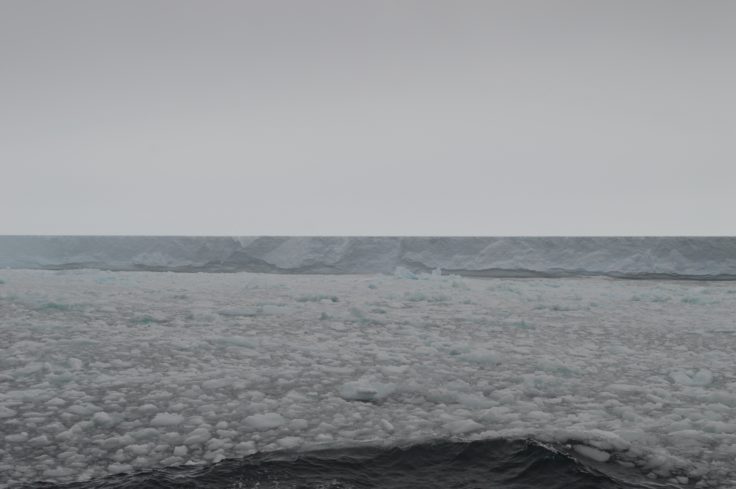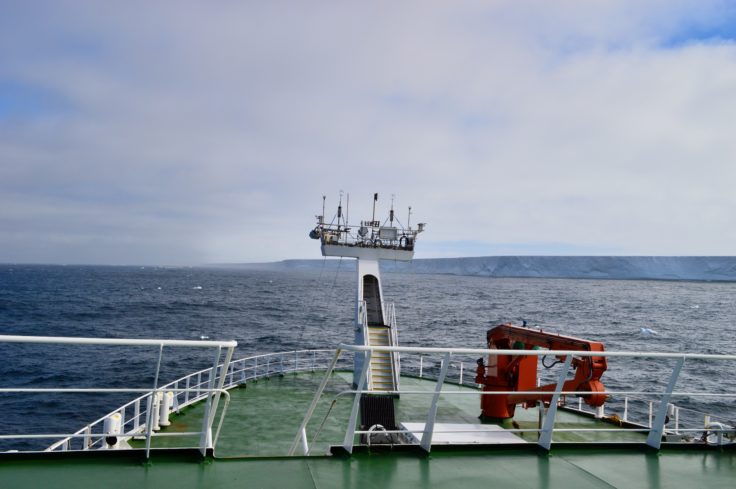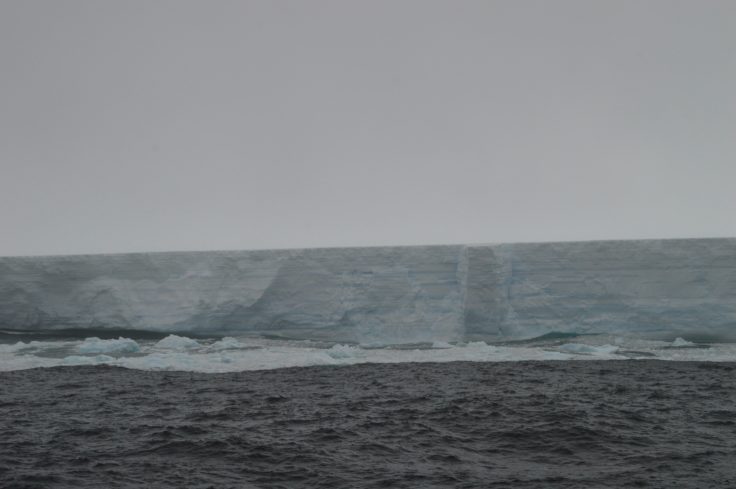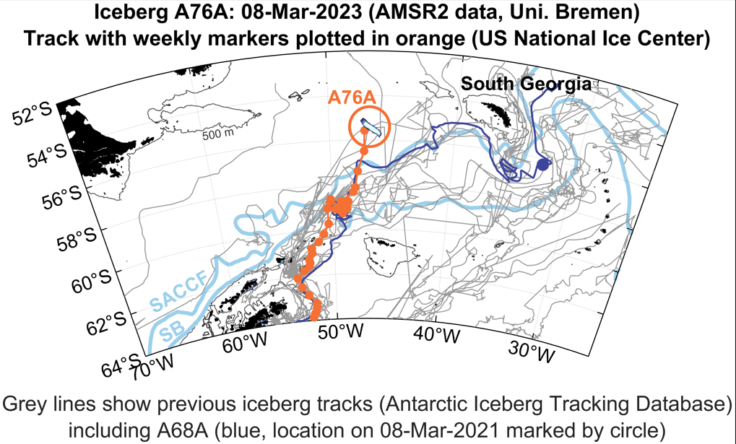This is the first footage of the massive A81 iceberg that calved from the Brunt Ice Shelf in late January 2023.
The iceberg is the size of Greater London!
As the summer team left the nearby British Antarctic Survey Halley Research Station they witnessed the start of the iceberg’s journey into the Weddell Sea.
A81 broke free when a large crack in the ice, called Chasm-1, extended across the entire ice shelf.
The iceberg is on the move and is now 150km away from where it broke off.
The Brunt Ice Shelf is one of the most closely monitored ice shelves on the planet and is home to Halley Research Station.
In fact, Halley used to be located on what is now the A81 iceberg, before a major operation was launched in 2016 to relocate the station 23km inland.
The calving has been long expected by scientists, who say this is a natural process in the lifecycle of a glacier.
This is the second major iceberg to come from the region in two years.
Monitoring by British Antarctic Survey glaciologists shows that the research station area currently remains largely unaffected by the calving event.
British Antarctic Survey (BAS) has released the first aerial pictures of the massive A81 iceberg that calved from the Brunt Ice Shelf in late January.
The iceberg is the size of Greater London.
As the summer team departed the nearby BAS Halley Research Station they witnessed from the air the start of the iceberg’s journey into the Weddell Sea.
The images show the dynamic nature of the iceberg surrounded by smaller icebergs which also broke away.
A81 broke free when a large crack in the ice, called Chasm-1, extended across the entire ice shelf.
It is now floating approximately 150km away from its origin.
The Brunt Ice Shelf is one of the most closely monitored ice shelves on the planet and is home to the BAS Halley Research Station.
Monitoring by BAS glaciologists shows that the research station area currently remains largely unaffected by the calving event.
This calving is a natural process along the Antarctic coastline with A81 the second major iceberg from the region in two years.
Glaciologist Dr Oliver Marsh studies the Brunt Ice Shelf and has just returned from Halley Research Station.
He says:
“This was a calving we knew was coming.
BAS has been monitoring the Brunt Ice Shelf and the chasms formed across it for over a decade.
Since glaciologists first observed Chasm-1 widening in 2012, BAS science and operations teams have been anticipating the calving event.
High precision GPS instruments as well as satellite data have been used to monitor widening of the chasm and in 2016 BAS took the precaution of moving the Halley Research Station inland to protect it.”
After breaking from the ice shelf, the iceberg has spun around and is heading south.
A81 is expected to follow in the footsteps of previous icebergs swept by the strong Antarctic Coastal Current westwards.
BAS scientists and the wider community will continue to track and monitor A81 as it continues to drift through the Weddell Sea and further north towards the South Atlantic basin.
Icebergs on the move
Another massive iceberg on the run is A76A.
This enormous chunk of ice is part of the A76 iceberg that began life after calving from the Filchner-Ronne Ice Shelf in mid-May 2021.
As it travelled north, A76 broke into three pieces, the largest of which is called A76A.
At 135km long and 25km wide, it is the largest floating iceberg on the planet – twice the size of Greater London – and is heading toward South Georgia.
 Iceberg A76a was captured by a team on the RRS Discovery.
Iceberg A76a was captured by a team on the RRS Discovery.Photo credit Chris Auckland (BAS)
As the iceberg reaches shallower waters, there is potential for disruption to the local wildlife around South Georgia and the nearby Shag Rocks.
If the iceberg grounds on the shallow seabed in the region it could destroy fauna across the seafloor and disrupt the ocean currents and foraging routes of the local wildlife.
In January, a team of BAS scientists onboard the RRS Discovery, operated by National Oceanography Centre, completed a circumnavigation of A76A sampling the waters around the iceberg to better understand its potential impacts on the environment.
 Scientists from BAS were doing research in the region and managed to circumnavigate the iceberg in just under 24 hours to collect measurements on how the freshwater from the iceberg is affecting the ocean.
Scientists from BAS were doing research in the region and managed to circumnavigate the iceberg in just under 24 hours to collect measurements on how the freshwater from the iceberg is affecting the ocean.Photo credit: Chris Auckland (BAS)
Professor Geraint Tarling, head of the Ecosystems team at BAS, was on board.
He says:
“An iceberg of this size will have a big impact on the ocean ecosystems which support the rich diversity of marine wildlife found in this Antarctic region.
These impacts may be both positive and negative.
On the positive side, as the iceberg melts, it will release a lot of nutrients that could benefit the growth of microscopic plants such as phytoplankton at the base of the oceanic food webs.
The negative side is that this same melting, at such a large scale, dumps lots of freshwater into the ocean which decreases salinity levels and makes the waters unsuitable for many phytoplankton and the zooplankton that feed on them.
These effects could then cascade up the food web to fish, birds, seals, and whales.
“In addition, if A76A continues along a trajectory towards Shag Rocks, gouging of the shallow seabed found there may be catastrophic for biodiverse seabed communities, including nursery areas for valuable fish stocks.”
Icebergs around South Georgia are not an uncommon sight.
The giant iceberg A68A reached the southern shelf of the island in 2021 causing concern that it could become grounded in the region.
As the iceberg approached South Georgia, it began to rapidly melt and broke into smaller fragments which were swept away from the island.
Nevertheless, wildlife around South Georgia will still have felt its impact with 152 billion tonnes, 20 times the volume of Loch Ness, of freshwater released by melting.
As well as the ecological impact, icebergs in the South Georgia region can present a great risk to local vessels.
Dr Mark Belchier, from the Government of South Georgia and the South Sandwich Islands, says:
“Our major concern at the moment is the possible risk for vessels operating in the region as the iceberg begins to break up and calve smaller chunks of ice.
It looks as though A76A may end up heading west of South Georgia, not east where A68 broke up, but there is still so much uncertainty around this.
We will be watching its movement closely.”

The team was able to get to within 500 metres of the giant A76a which is twice the size of Greater London and the largest floating iceberg on Earth.
Photo credit: Chris Auckland (BAS).
Photo credit: Chris Auckland (BAS).

A81 iceberg
- Measures in at 1550 km2 approximately the size of Greater London
- Calved from the Brunt Ice Shelf on the 22nd of January 2023 and has travelled approximately 150km south following the coastline
- Formed from the Chasm-1 crack which lay dormant until 2012 and has been closely studied by BAS
- Expected to follow the Antarctic Coastal Current around the Weddell Sea as with previous icebergs
- Measuring in at approximately 3200 km2 and is shaped like a giant ironing board
- Calved from the Filchner-Ronne Ice shelf in mid-May 2021 and was first spotted by BAS oceanographer Keith Makinson
- Broke into three chunks with the largest heading towards Shag Rocks and the island of South Georgia
- Potential for large disruption to local wildlife as it releases massive volumes of freshwater and nutrients as well as disrupting ocean currents and blocking wildlife foraging routes
No comments:
Post a Comment